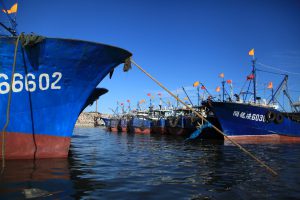When his vessel is still far out to sea, the captain uses a mobile phone app to notify the port of his arrival. He specifies what time he’ll get in, and submits catch data that the port managers will later check.
This is how it works off Taizhou, on China’s eastern coast, where trials of a system designating the ports at which domestic fishing vessels can land their catches have been running since 2018. A traceability trial has also been running in parallel: each crate of fish is barcoded so it can be tracked from when it was caught to the port and then on to market. By scanning the code with a mobile phone, anyone along the supply chain can see this information as well as where the fish were caught and by which boat.
The Ministry of Agriculture (MOA) announced a first batch of 66 designated ports last year. The plan is to have enough ports approved by the end of 2021 to accommodate all fishing vessels of 12 metres or more in length. At which point, the MOA may ban the landing of catches elsewhere. Although China has more than twice as many vessels shorter than 12 metres, the longer group has almost seven times the total horsepower and accounts for the bulk of Chinese coastal fishing capacity.
The designated port scheme is part of overall reforms to the management of ports and fishing vessels in China. While previous oversight focused on vessels at sea, the new reforms aim to allow sustainable fisheries management, with better reporting of when vessels enter and leave, and various checks, including of landed catches, catch quantity, legal compliance and vessel safety management. These will all be handled at the port, where fishing sector workers, vessels and catches come together.
Why designate ports?
“The designated ports are a very important starting point for our reforms, and will solve issues with checking data on catches landed,” Tang Yi, a professor at Shanghai Ocean University, told China Dialogue Ocean.
Currently, China’s catch statistics are reported upwards through various levels of fisheries authorities, and discrepancies can be quite large. But as the ports are a bottleneck through which all fish must pass as they move from sea to table, the designation system should allow landed weight information to be reported accurately and properly checked.
This data matters for sustainable fisheries management. The fishing quota system included in the version of China’s Fisheries Law that was revised in 2000 has never been implemented due to problems with data, oversight of the fish trade and technology.
Without monitoring catches on their arrival in port and transfer to market, fish are landed and sold freely. That has allowed over-fishing, reducing the effect of both controls on fishing capacity and stricter closed seasons.
Limits on vessel numbers and horsepower date back to the late 1980s and have featured in a number of China’s five-year plans for economic development. But data from 2003 to 2014 show that while vessel numbers fell, overall horsepower rose. Experts put that failure down to a lack of enforcement. There was, for example, nothing to stop a large vessel registering as a smaller one. The first closed seasons started in 1995 and they were lengthened in 2017, but while these protected fish during spawning, they did nothing to curb over-fishing at other times.
Since 1995, China’s annual coastal fishing catch has always been over 10 million tonnes. In 2016, it reached 13.28 million, far above the level recommended by experts. The fish caught are becoming younger and smaller as a result of this overfishing.
It was only in 2017 that a system for comprehensively managing ocean fisheries became a major item on the Ministry of Agriculture’s agenda. This meant China would start managing fishing catches, alongside existing controls on vessel numbers and total horsepower. That year, Dongying in Shandong and Taizhou in Zhejiang began the country’s first trials of fishing quotas. The following year, Taizhou trialled a system that combined management of both fishing ports and fishing vessels. The designated port system, and the associated traceability scheme, are part of these ongoing reforms. In the future, ports will be more than places where boats moor, unload and supply – they will be fishing management hubs.
What is a designated port?
There’s no official word yet on how the designated port system will actually work. But the trials in Taizhou provide a clue. First, decide on total allowable catches and allocate those quotas to fishing vessels. Then monitor catches and trading, and carry out checks at designated ports. Meanwhile, ensure traceability to monitor the total catch and prevent illegal fishing.
Certain things need to be in place to achieve all this: managers and law enforcement officials based at the port; a designated fish market for trading; appropriate facilities for unloading the fish; and electronic monitoring equipment at the harbour mouth. The real challenge is ensuring all these systems work together.
The port office at Shitang in Taizhou has a port management system that allows it to see which vessels are arriving and leaving in real time. An electronic barrier at the mouth of the harbour identifies vessels arriving that have not registered, so they can be checked. Vessels participating in the trial have satellite trackers fitted so their location can be seen at all times, in all weathers. And barcodes let the fishing boats, catch carrier vessels and buyers at port report what they’ve caught or purchased directly to the management system. Getting all that up and running is expensive, and it takes some time to bed in.
The trials in Taizhou and Yantai have somebody to help with this. The “port chief” coordinates changes and keeps an eye on progress. When it becomes necessary to work across various domains – fishing authorities, planning authorities, government finance, market oversight, environmental protection, meteorology, fire-fighting – the port chief acts as the go-between and decision maker.
In April 2019, a meeting on the port and fishing vessel reforms proposed a full roll-out of the port chief system. Ports including Zhoushan in Zhejiang, Nantong in Jiangsu and Weihai in Shandong issued plans for implementation, using the port chief system as the starting point.
When is it happening?
We aren’t going to see a nationwide roll-out of designated ports right away. A full list of them is only due by the end of the year. According to one fisheries expert, there will be two new batches announced before then, but it is unclear when the system will be fully implemented.
The ports announced so far are not evenly distributed. Shandong and Guangdong have the most, with 24 and 18, but the Liaodong peninsula and Fujian have one and three, despite having just as many ports. It seems some provinces have not yet applied, judging by 2018 data on the number of ports nationwide. Some of these may not have the necessary conditions in place. But then, according to the expert mentioned above, local governments do not need to apply for designated port status even once those conditions are in place.
China’s larger ports are categorised as Central, Tier 1 or Tier 2, in descending order of size. In 2018, China published development plans for its ports up until 2025, with the aim of improving safety and management. Under those plans, the number of Central and Tier 1 ports will reach 237 by 2025, while Tier 2 ports and (the even smaller) shelter anchorages are to be upgraded and repaired. Central, Tier 1 or Tier 2 ports will be the main sites for fish landing in the future.
Of course, the question of the smaller fishing vessels also needs to be addressed if sustainable fishing is to be achieved in China’s waters.
Small vessels currently make up half of the domestic motor-powered fishing fleet. There are 150,000 of them and in places like Shandong, Fujian, Guangdong and Hainan they account for 70% of all vessels. Most belong to subsistence fishers, but their catch cannot be overlooked. These boats can also transfer catches between the larger fishing vessels and ports.
The designated ports system for larger fishing vessels and the traceability scheme are included in a draft of a new revision to the Fisheries Law that was published in 2019. The draft also rules that designated ports and traceability for small fishing vessels will be implemented via city-level fishery authorities. That revision is not yet law, and it is not known how or when local governments would do this implementing. But if it does not happen promptly, it may undercut the effectiveness of the designated port scheme for larger vessels.




![Saat mule (seven springs)—source of water for Nepal’s first hydropower project installed in 1911. Locals have built seven spouts and use this water for drinking and other purposes. Rest of the water goes to the reservoir pond [image by: Ramesh Bhushal]](https://dialogue.earth/content/uploads/2021/02/untitled-01-300x200.jpg)

![Tsering standing on an outcrop observing her pashmina goat flock [image by: Stanzin Dorjai Gya]](https://dialogue.earth/content/uploads/2021/02/DSC07391-300x200.jpg)

